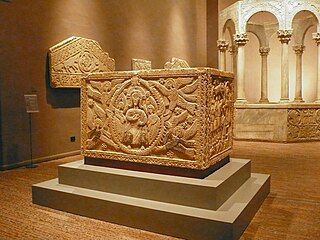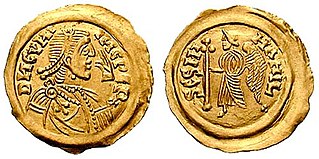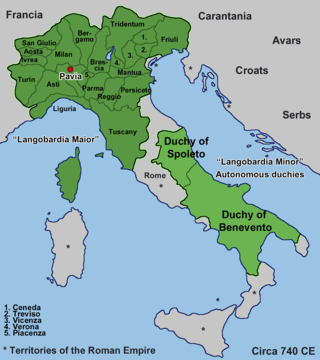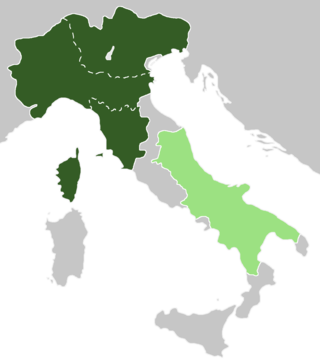Sources
- Paul the Deacon. Historia Langobardorum. Translated by William Dudley Foulke. University of Pennsylvania: 1907.
- Hodgkin, Thomas. Italy and her Invaders. Clarendon Press: 1895.
Ado (or Ato) (died 695) was the Duke of Friuli after the usurper Ausfrid was defeated at Verona in 694. According to Paul the Deacon, he was a brother of the former duke Rodoald and ruled for a year and seven months. The actual length of his reign is disputed, as is the year of its occurrence. He appears with the title loci servator (caretaker) and may have only held the duchy as regent on behalf of the king.
A certain Ado fought with Raginpert against Liutpert in 702, but the identification of this duke with Ado of Friuli is disputable.

Paul the Deacon, also known as Paulus Diaconus, Warnefridus, Barnefridus, or Winfridus, and sometimes suffixed Cassinensis, was a Benedictine monk, scribe, and historian of the Lombards.

Year 799 (DCCXCIX) was a common year starting on Tuesday of the Julian calendar. The denomination 799 for this year has been used since the early medieval period, when the Anno Domini calendar era became the prevalent method in Europe for naming years.
Callinicus was the exarch of Ravenna from 597 until 602 or 603. He is called Gallicinus, or Gallicini patricii, by the Lombard historian Paul the Deacon.

Ratchis was the Duke of Friuli (739–744) and then King of the Lombards (744–749).

Cunipert was king of the Lombards from 688 to 700. He succeeded his father Perctarit, though he was associated with the throne from 680.
The Rule of the Dukes was an interregnum in the Lombard Kingdom of Italy (574/5–584/5) during which part of Italy was ruled by the Lombard dukes of the old Roman provinces and urban centres. The interregnum is said to have lasted a decade according to Paul the Deacon, but all other sources—the Fredegarii Chronicon, the Origo Gentis Langobardorum, the Chronicon Gothanum, and the Copenhagen continuator of Prosper Tiro—accord it twelve years. Here is how Paul describes the dukes' rule:
After his death the Langobards had no king for ten years but were under dukes, and each one of the dukes held possession of his own city, Zaban of Ticinum, Wallari of Bergamus, Alichis of Brexia, Euin of Tridentum, Gisulf of Forum Julii. But there were thirty other dukes besides these in their own cities. In these days many of the noble Romans were killed from love of gain, and the remainder were divided among their "guests" and made tributaries, that they should pay the third part of their products to the Langobards. By these dukes of the Langobards in the seventh year from the coming of Alboin and of his whole people, the churches were despoiled, the priests killed, the cities overthrown, the people who had grown up like crops annihilated, and besides those regions which Alboin had taken, the greater part of Italy was seized and subjugated by the Langobards.
Gisulf I was the duke of Benevento from 689, when his brother Grimoald II died. His father was Romuald I. His mother was Theodrada, daughter of Duke Lupus of Friuli, and she exercised the regency for him for the first years of his reign.
Gisulf II was the Duke of Friuli from around 591 to his death. He was the son and successor of Grasulf I of Friuli.
Tasso was the joint Duke of Friuli with his younger brother Kakko from their father's death (611) to their own. Their father was Gisulf II and their mother Romilda of Friuli. In or around 611, Gisulf was killed fending off an Avar invasion.
Kakko was the joint duke of Friuli with his elder brother Tasso from their father's death (611) to their own. Their father was Gisulf II and their mother Romilda of Friuli. In or around 611, Gisulf was killed fending off an Avar invasion.
Grasulf II, son of Duke Gisulf I, was the Duke of Friuli after the assassination of his nephews, Tasso and Kakko, in Oderzo in 616 or 617. His other nephews, Radoald and Grimoald, left Friuli for the Duchy of Benevento because they did not wish to live under Grasulf. Nothing more is known about Grasulf and the date of his death is uncertain. He died at Cividale.

Gisulf I was probably the first duke of Friuli. He was a nephew of Alboin, first king of the Lombards in Italy, who appointed him duke around 569 after the Lombard conquest of the region,
Ago was the Duke of Friuli from between 651 and 661 until about 663. He succeeded Grasulf II.

The Duchy of Friuli was a Lombard duchy in present-day Friuli, the first to be established after the conquest of the Italian peninsula in 568. It was one of the largest domains in Langobardia Major and an important buffer between the Lombard kingdom and the Slavs, Avars, and the Byzantine Empire. The original chief city in the province was Roman Aquileia, but the Lombard capital of Friuli was Forum Julii, modern Cividale.
Wechtar, a Lombard from Vicenza, was the Duke of Friuli from 666 to 678. He took control of Friuli at the command of King Grimoald following the rebellion of Lupus and Arnefrit and the invasion of the Avars. According to Paul the Deacon, he was a mild and fair ruler.
Peter or Petrus was the reputed son of Munichis and brother of one Ursus. Paul the Deacon records that Munichis died in the same battle as Ferdulf, Duke of Friuli, and that his son Peter and Ursus later became dukes of Friuli and Benevento respectively. The date of Peter's reign is unknown, but has been hypothesised as following that of Aistulf or Anselm in 756 or 751 and lasted until the Siege of Pavia.
Ansfrid, Ansfrit, or Ausfrid was the Duke of Friuli in 694. He was originally the lord of the castle of Ragogna.
Corvulus was the Duke of Friuli for a brief spell in the early eighth century AD. He replaced Ferdulf, but he offended King Aripert II and was arrested and his eyes gouged out. He lived in obscurity and shame as a blind exile thereafter, according to Paul the Deacon. He was ultimately replaced by Pemmo.
Ferdulf or Fardulf, originally from the territories of Liguria, was the Duke of Friuli at some point between the end of the reign of Cunincpert (688-700) and the beginning of that of Aripert II (701-12). There is no evidence to associate his tenure to the year 705 alone or indeed to suggest that it was very brief.. Paul the Deacon described him as 'a man tricky and conceited' who had obtained the dukedom after the death of Duke Ado.

Austria was, according to the early medieval geographical classification, the eastern portion of Langobardia Major, the north-central part of the Lombard Kingdom, extended from the Adda to Friuli and opposite to Neustria. The partition had not only been territorial, but also implied significant cultural and political differences.